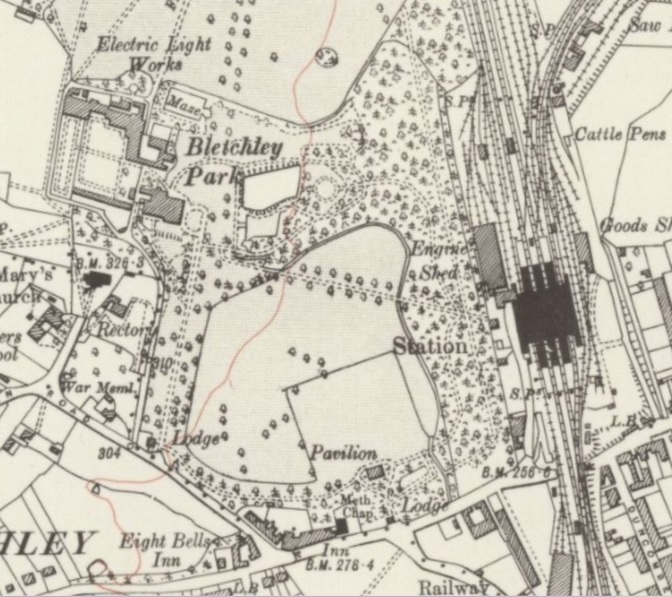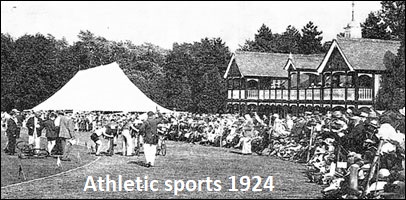


The cricket pitch was sometimes used for county games and had an impressive pavillion. Rather than using the long cycle track, bicycle racing usually took place on a track marked out on the cricket pitch.
The Buckinghamshire Police held their annual sports at Bletchley Park from 1907 to 1923. The first bicycle races were the Police Sports on July 18th 1907, the bicycle events were 1 mile policemen's race, 1 mile handicap for men under 35 years old and open handicap races over 1 and 2 miles. The attendance was around 5,000 and the sports contributed about £2,000 each year to charities. The Band of the Grenadier Guards played at the event.
The first Bletchley Park Show was held on August 1st 1910 by the Bletchley and Fenny Bentley Horticultural Society. There was horse jumping and driving competitions and athletic sport and cycle races. The show was a huge success with 20,000 people paying a shilling to attend. The bicycle events included ½ mile and 1 mile open handicap races and an open ½ mile scratch race.
After a lapse of six years, the Bletchley Show resumed in 1920 with the usual cycle races. Herbert Leon died in 1926, but the Bletchley Show and cycle racing was continued by his wife Fanny. Of the four cycle races at the 1931 Show, the main event was the one mile NCU (Northampton Centre) Championship. The main Show attendance was 16,000 and 5,000 people attended the sports. The last Bletchley Park Show was held in 1937, the year in which Fanny Leon died.
After WWII, sporting activities at Bletchley Park resumed when Bletchley Town Sports Club put on athletic and cycle meetings, which later expanded to the Bletchley Show. These events started in 1949 and ran until 1960. At the August Bank Holiday event in 1950, there were 6,000 spectators and the cycling events were a 440 and 880 yards scratch races, 440 and 880 yards handicap races, a devil-take-the-hindmost and the NCU (Northampton Centre) 5 miles Championship. The last cycle racing at Bletchley Park was at the Bletchley Show on August 1st 1960.
The history of Bletchley Park through the war is fascinating. After Fanny Leon's death, the house and 58 acres of the estate were put up for sale in 1938. As war was approaching, Bletchley Park was selected by MI6 as a suitable, out of London, site for to the Secret Service to use. The government could not provide the cash to buy Bletchley Park, so Admiral Sir Hugh Sinclair, head of MI6, bought it for £6,000 with his own money.
During World War II, the Government Code and Cypher School was based at Bletchley Park, with codebreakers included Alan Turing, Gordon Welchman, Hugh Alexander, Bill Tutte, and Stuart Milner-Barry. The work of the code breakers was very significant in the British victory over the Nazi's in WWII. The operations came to an end in 1946 and all information was classified until the mid-1970s.
The Bletchley Park Trust was formed in February 1992 and a large amount of Bletchley Park was saved and the site is now open to the public, together with the National Museum of Computing.